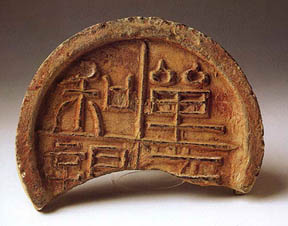
Xiongnu/Western Han dynasty
206 BC - AD 25
Earthenware pottery
D: 15.5 cm
From Zhaowan Site in Baotou
Image courtesy of the Inner Mongolian Museum, Huhehaote (copyright reserved)
This tile was original cylindrical in shape; all that is preserved is one of the end pieces. It was retrieved from a tomb found in Inner Mongolia, an area inhabited by the Xiongnu; the inscription, however, leads archeologists to surmise it is of Han Chinese manufacture. The inscription is significant for other reasons as well, for it offers us information into the nature of the relationship between of the Xiongnu and the Han Chinese at this time.
The inscription, written in clerical script, reads "Conjugal amity with the Shanyu," which tells us the tile was intended to commemorated a political marriage between the Xiongnu and Han ("shanyu" was the term for the head of the Xiongnu confederacy). This was in following with the Han's so-called ho chin policy they negotiated with the Xiongnu, which consisted of four provisions:
- The Han offered annual tribute to the Xiongnu in the form of silk, gold, clothing, wine, rice, and other goods and foodstuffs.
- The Han regularly offered women of royal birth to the Xiongnu leaders to serve as wives and hostages.
- The Xiongnu and Han states were to be considered equal in status.
- The Great Wall was to serve as the official border between the two state
(1)
This policy did more than simply enrich the Xiongnu and provide them with high-status wives. It also supplied them with trade goods, for much of the wealth they received from the Han were redistributed or exchanged with other nomadic groups to the west and north; Chinese silk has been found in tombs dating to this period as far as the Noin Ula mountains in northern Mongolia.
(1) Thomas J. Barfield, The Perilous Frontier: Nomadic Empires and China (Oxford: Basil Blackwell Ltd., 1989), p. 46.